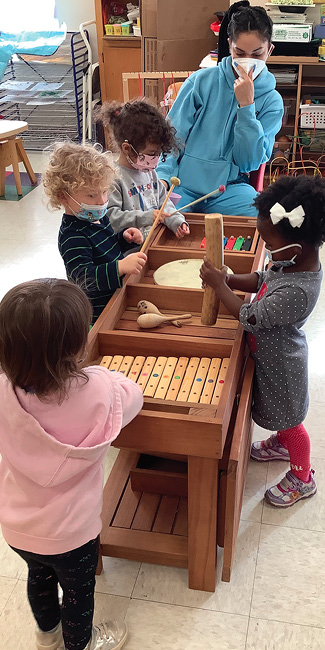The Early Years
Sound Activities and Investigations With Preschoolers
Science and Children—May/June 2022 (Volume 59, Issue 5)
By Shelly Lynn Counsell

Science is a way of knowing by means of observation or experience, beginning in the earliest years. Young children encounter many different kinds of physical science phenomena—especially sounds—providing almost endless opportunities to experience and explore. As young children handle objects, they observe and hear the sounds they make, sometimes by chance, as when items are dropped, or as they complete daily tasks, such as touching items together (e.g., a bowl and spoon as they eat). When provided with a variety of objects and containers (none with sharp edges or breakable, such as glass) educators can ask, “How can I make sound with these materials?” Challenging children to make sounds helps to initiate the engineering design process as children first imagine, then contemplate the many possibilities, acting on individual items or combined materials to produce sound. As preschoolers investigate how different materials can vibrate and produce sound, they may encounter many unexpected problems, failures, or surprises that further challenge them to find creative solutions by revising or changing, and eventually improving their design ideas. Multiple investigations with different materials help them to carefully observe which materials vibrate to make sound and how sound can make materials vibrate as they become increasingly sophisticated problem-solvers (Bagiati and Evangelou 2011).
During sound investigations, children also begin to observe and distinguish sound characteristics such as volume (the range from loud to soft sounds) and pitch (ranging from high to low sounds). The size of the vibration (amplitude) determines the loudness of the sound; the bigger the vibration, the louder the sound. On the other hand, pitch is determined by the frequency or speed of the vibration (sound wave). A greater frequency will result in a higher pitch whereas a lower frequency will result in a lower pitch. The density of material influences how quickly or slowly sound waves travel. Sound waves travel most quickly through solids, a slower rate through liquids, and at the slowest rate through gases.
MATERIALS
- An assortment of rubber bands
- Peg board
- Workout bands and wooden loom
- Container items (cardboard boxes, milk cartons, margarine tubs, metal bowls or cans, wooden boxes)
- Striking materials (wooden, plastic, or metal spoon, chopsticks, paper towel tube)
- Cultural instruments (guitar, banjo, mandolin, harp, harpsichord, zither, bandura, bangos, conga drums, castanets, maracas)
- Online early STEM activities
Investigating Sound, Vibration, and Pitch With Rubber Bands
Rubber bands’ elasticity allows them to be maneuvered by young children with relative ease. In one investigation, children stretch standard office rubber bands to different lengths and tensions on a pegboard. As children pluck each rubber band, they observe the vibrations and the sound that each rubber band makes, listening for higher and lower pitches. Repeated observations and experiences are used by children to construct mental relationships about tension and pitch. When children increase the tension (more tightness by stretching the rubber band over a longer length), the faster the vibration, the higher the pitch. When children decrease the tension (less tightness by stretching the rubber band over a shorter length), the slower the vibration, the lower the pitch. Goggles are recommended for working with rubber bands. Be aware of latex allergies.
If young children struggle with verbalizing the mental relationships between tension and pitch, educators can help scaffold their scientific thinking and reasoning using productive questioning (Elstgeest 2001; Martens 1999) like the following:
Attention-Focusing: What do you notice about how the rubber band moves (vibrates)?
Action: What happened to the pitch when you stretched the rubber band longer? What happened to the pitch when you stretched it shorter? How did the rubber band move (vibrate) when you did that?
Comparison: Which rubber band has the highest pitch and which one has the lowest pitch?
As children apply their scientific knowledge about how different types of vibrations produce different types of sounds, they can actively use design thinking to investigate:
- What happens to the sounds and vibrations when they use rubber bands with different sizes and densities, including large workout bands stretched on a loom.
- How sounds and vibrations change when they stretch the rubber bands across different containers (e.g., cardboard boxes, milk cartons, margarine tubs, metal bowls or cans, wooden boxes).
- How to make sounds and vibrations by tapping containers and observing what happens (e.g., tapping plastic, metal, cardboard, or wooden containers with a wooden, plastic, or metal spoon).
- Discuss how engineering design is used to create different types of string (e.g., guitar, banjo, mandolin, violin, viola, harp, harpsichord, zither, and bandura) and percussion (e.g., drums, bangos, conga drums, snare drum, cymbals, castanets, maracas) instruments from different countries and explore how each is used to combine sound, pitch, volume, and amplitude to make different styles of music.
Primary grade children can document their experiences in science journals.
Acknowledgment
Thank you to Lynn Goldsmith, EDC Distinguished Scholar/Adviser and Educational Researcher; Cindy Hoisington, EDC Professional Developer and Instructional Designer; and Carol Cordeau-Young, University Preschool Teacher at the University of Memphis Barbara K. Lipman Learning and Research Center for graciously sharing photos and inspiring children’s STEM learning experiences with sound phenomena.
Shelly Lynn Counsell (slcnsell@memphis.edu) is an associate professor of early childhood education at the University of Memphis.
The Education Development Center (EDC), a premier organization and educational leader in the creation of innovative early STEM curricula and professional learning and preparation has developed an early STEM curriculum, Insights+C Elementary Science (2021) with investigations exploring light and sound with first graders that can be easily adapted to preschool. The Insights+C Unit on Sound currently includes nine activities that encourage children’s exploration and investigation by comparing and matching sounds; feeling vibrations; making vibrations visible; exploring pitch with rubber bands; playing with volume; investigating how sound travels; and using sound to communicate over distances (http://go.edc.org/insights-science).
Earth & Space Science Physical Science Teaching Strategies Early Childhood


